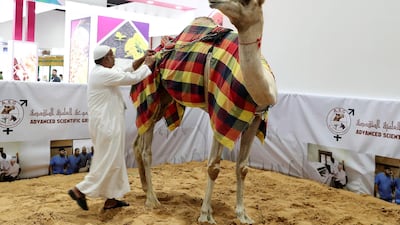The three judges methodically patrol 17 adjoining pens. Their stern faces give nothing away.
Occasionally, a long, plastic stick is thrust out, in the direction of a good-looking specimen deemed worthy of closer inspection.
The sheep, or goat, depending on the category, is then herded out into a temporary courtyard, where there is room for its gait to be carefully studied.
Occasionally, the trio consult quietly and make secret notes.
“Look at them, all of them, they are worried and they will be until they get the results,” said Fahad Mousa Al Huraiji, pointing towards his fellow breeders, their anxious eyes fixed on the judges who will pick a new champion.
“This is competition. It should not be too serious, but everybody wants to win.”
For many attending the EuroTier animal farming fair, which opened in Abu Dhabi yesterday, the “beauty contests”, as they were described by organisers, are a star attraction.
More than 40 prizes will be handed out across categories for seven different sheep and goat breeds over the coming days, and breeders have come from across the region to take part.
And it is not just for the glory of winning, or even the “significant” cash prizes on offer, that make the competitions such a serious business. An award can mean a major boost to profits in the long term.
“He [the breeder] has a breeding line,” said Mr Al Huraiji, who had come to show off the pygmy goats he breeds in Al Ahsa, Saudi Arabia, which he hopes will become popular domestic pets in the region.
“With a certain specification like a competition victory, he will be happy. His animals will be more valuable. So the owners will have gone to a lot of effort to make sure their animals are clean, looking their best.”
What it is that makes a goat or sheep beautiful depends on the breed. Mr Al Huraiji’s pygmy goats, which are not in a competition but were brought to the show in an effort to promote them as playful and cute house pets, are judged on several factors.
The smaller the better. A pretty pygmy should have a wide nose, head, mouth and big eyes. Its neck should be short, its chest wide and its back round.
In most other categories, such as for the Ardi Goats which were being judged yesterday, height is usually seen as a sign of beauty.
Width and a large head also desirable characteristics. For the najdi sheep, a steeply curved face is essential. For the nuami sheep, meanwhile, careful attention is paid to the markings on its face. One other breeder confides that an animal with open, confident posture with the legs wide apart – a sort of “power pose” – can often sway the judges.
Finalists are carefully selected, before a winner is finally announced.
But the contests are not all about the superficial, according to Sultan Al Rasheedi, who is in charge of the auctions and shows team at EuroTier.
Before being brought into the public exhibition area, the animals are weighed in a tent and given a preliminary examination by judges.
During the three-day show there will also be competitions for milk production, weight and meat quality, meaning it is not just how the animals look that is important.
For the beauty contests, six categories are open for each of the three breeds of sheep and four types of goat catered for. These include best male and female, best ewe or doe, and the best selection of five animals from any specific species.
While animal contests are common throughout the region, yesterday was the first event held in the Middle East to feature live animal beauty contests take place within a trade fair, organisers said.
Alongside the contests and judging at the Abu Dhabi National Exhibition and Conference Centre, there were academics giving talks about camel reproduction and health and a series of businesses, offering everything from animal feed to farm machinery.
Later, there was an auction, in which individual animals in the competitions were put up for sale.
“You will grade the animals by the body, by the [genetic] line they come from, and it all helps create the next generations,” Mr Al Rasheedi said.
“The competition improves the breeding and the judges select the best thing for all of the farms, because we look at things like meat quality.
“After that, you can improve the numbers and quality of the breed. This supports the meat market, the milk market and food security. This shows the farmers how to care for production more.
“People have come from Kuwait, all over the GCC. Some breeders have also come from Africa, and I think next year, people will come even further, perhaps even from Europe.
“You can see people are happy to come here, to see each other.
“But every person wants to win the competition, to then be able to say they are the champion.”











